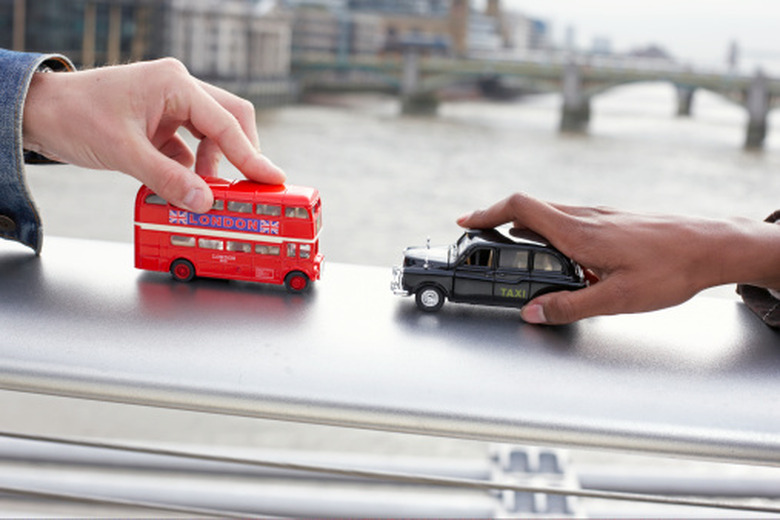Acceleration Lab Activities In Physical Science
Acceleration is different than speed. In physics there are a few interesting experiments to measure acceleration. By combining these practical techniques with a simple equation involving the speed of an object moving and the time it takes that object to travel a specified distance, acceleration can be calculated.
The Moving Car
The Moving Car
A moving car experiment is a straightforward way of demonstrating that acceleration is a measure of the change of speed of an object using a "photogate." Photogates use single beams of ultraviolet light to detect a moving object as it passes. They can measure speed to a high degree of accuracy. A toy car can be mounted at the top of a simple flat ramp, such as a length of cardboard or wood. Make sure the ramp is not slippery, or the results will be skewed. The distance from the top to the bottom is measured using a tape measure. The car is rolled down the ramp four times, starting from different points, and timed using a stopwatch. The point at which it passes the finish line can be recorded by the photogate. The results are plotted on a graph to show how the different speeds correspond to an acceleration. Try to measure the time intervals to the nearest 0.0001 seconds and the distances and speeds of the car to the nearest 0.1 cm/s, according to The Science Desk.
Walking and Running
Walking and Running
Classroom students can make use of their scientific knowledge outside in this engaging experiment. Make sure they know about basic physics first. The equation used to calculate the speed of an object is speed equals distance divided by time. The equation to calculate acceleration is the change in speed (or velocity) divided by the change in time. If the acceleration of an object does not change for different time intervals, it is referred to as a "constant" acceleration, as described by Think Quest. Working in pairs, students can time each other walking a specified distance to calculate their speed of motion; then, they can start looking at acceleration by starting from a walk and moving into a run. Ask them to determine which person can accelerate the fastest, record the results, then compare them back in class.
The Moving Car 2: Force and Acceleration
The Moving Car 2: Force and Acceleration
This experiment works like the basic moving car experiment, but here you can incorporate how a force acting upon an object in motion changes the way the object moves. According to the website "Science Class," you need to tie a 60-cm piece of string to a paper clip and, at the other end, to a toy car. The car is placed on a work desk, with the string hanging over the edge so the paper clip dangles in the air. A triple beam balance is used to measure the mass of a range of weights. The weights can be formal weights from the lab or a range of small objects the students select from their surroundings. The masses of all the chosen weights need to be measured accurately and recorded. Ask the students to write down predictions about how the car will move with different weights attached, then let them see what happens when you hang the weights from the paper clip and measure the motion of the car. Heavier weights will produce a faster speed and a higher rate of acceleration.
Changing Mass, Force and Acceleration
Changing Mass, Force and Acceleration
This changing mass experiment demonstrates Newton's Second Law of Motion. This describes the behavior of a moving object when the forces acting on it are not balanced, which is another way of looking at the phenomenon of acceleration. The value of acceleration of an object depends on the net forces acting on it. If two equal forces from either side act on an object, it will stay put because the forces cancel one another out. So, to demonstrate this concept, another small car can be used as the object in motion, and a range of different weights can be added to it. The mass of the cart and weights all need to be measured and recorded. A spring scale is attached to the car with a paper clip. Pulling the car along using the spring scale will result in a measurement of force appearing on the scale. By adding different weights and pulling the car at a constant velocity, it is possible to measure the increasing amount of force needed to move the same distance. The acceleration of the object is equal to the net force acting upon it divided by its mass.
Cite This Article
MLA
Parks, Natasha. "Acceleration Lab Activities In Physical Science" sciencing.com, https://www.sciencing.com/acceleration-lab-activities-physical-science-8223902/. 24 April 2017.
APA
Parks, Natasha. (2017, April 24). Acceleration Lab Activities In Physical Science. sciencing.com. Retrieved from https://www.sciencing.com/acceleration-lab-activities-physical-science-8223902/
Chicago
Parks, Natasha. Acceleration Lab Activities In Physical Science last modified August 30, 2022. https://www.sciencing.com/acceleration-lab-activities-physical-science-8223902/
